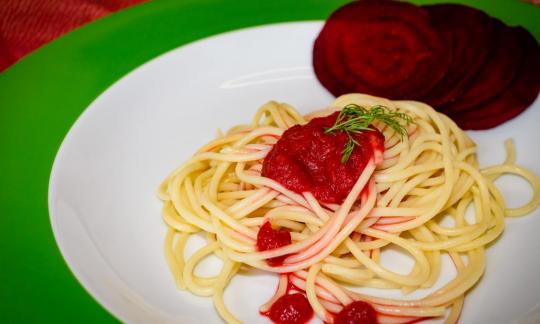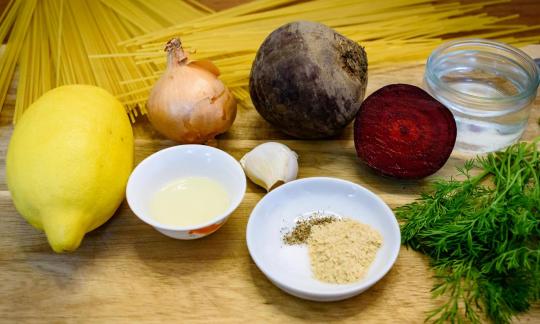Beetroot pasta sauce with dill and lemon juice
vegan
Ingredients (for servings, )
| 5 ½ oz | Beetroot, raw (organic?) |
| 1 | Onions, raw (organic?) (3.9 oz) |
| 2 cloves | Garlic (organic?) (0.21 oz) |
| 1 tbsp | Rapeseed oil, refined (organic?) (0.49 oz) |
| 200 ml | Drinking water, raw (organic?) (7.0 oz) |
| 1 dash | Table salt (table salt, raw?, organic?) (0.01 oz) |
| 1 dash | Black pepper (organic?, raw?) (0.00 oz) |
| Optional | |
|---|---|
| 1 tbsp | Yeast flakes: noble yeast, nutritional yeast, yeast powder (raw?, organic?) (0.10 oz) |
| 2 tbsp | Lemon juice (raw?, organic?) (0.51 oz) |
| Optional | |
| 2 tbsp | Dill, raw (herb, seeds, organic?) (0.20 oz) |
Equipment
- hand-held blender / immersion blender
- vegetable peeler
- stove
- citrus juicer (lemon squeezer)
- saucepan
Type of preparation
- chop or grind
- squeeze
- sweat
- season to taste
- purée
- remove the skin
- peel
Preparation
Preparing vegetables
Clean and peel the beetroot and cut into small cubes. Peel the onion and dice finely. Peel the garlic. Squeeze the lemon and wash and finely chop the dill.150 grams of beetroot corresponds to approximately one medium-sized tuber.
Preparing the sauce
Put oil in a pan and heat. Add onion and sauté over medium heat. Add garlic and beetroot and sauté for about 2 minutes. Pour in water and simmer with the lid closed for about 10-15 minutes.finishing and serving
Puree the sauce with a hand blender. Season to taste with salt (and optionally nutritional yeast flakes), pepper and freshly squeezed lemon juice.Serve sauce with any type of pasta and optionally with chopped dill as a topping.
The pasta in the recipe picture is only an example. For health reasons, we recommend using wholemeal pasta or gnocchi - preferably homemade.
|
Nutritional Information per person
Convert per 100g
|
2000 kcal | |
|---|---|---|
| Energy | 129 kcal | 6.5% |
| Fat/Lipids | 7.3 g | 10.4% |
| Saturated Fats | 0.56 g | 2.8% |
| Carbohydrates (inc.dietary fiber) | 15 g | 5.4% |
| Sugars | 7.6 g | 8.5% |
| Fiber | 3.5 g | 14.2% |
| Protein/Albumin | 2.8 g | 5.7% |
| Cooking Salt (Na:145.4 mg) | 369 mg | 15.4% |
| Essential micronutrients with the highest proportions | per person | 2000 kcal | |
|---|---|---|---|
| Vit | Vitamin B1 (Thiamine) | 0.63 mg | 57.0% |
| Vit | Vitamin B9, B11 (Folate, as the active form of folic acid) | 102 µg | 51.0% |
| Fat | Alpha-Linolenic acid; ALA; 18:3 omega-3 | 0.66 g | 33.0% |
| Min | Manganese, Mn | 0.41 mg | 21.0% |
| Vit | Vitamin E, as a-TEs | 2.4 mg | 20.0% |
| Elem | Potassium, K | 365 mg | 18.0% |
| Sodium, Na | 145 mg | 18.0% | |
| Vit | Vitamin C (ascorbic acid) | 14 mg | 17.0% |
| Vit | Vitamin B6 (pyridoxine) | 0.19 mg | 14.0% |
| Fat | Linoleic acid; LA; 18:2 omega-6 | 1.3 g | 13.0% |
Detailed Nutritional Information per Person for this Recipe
The majority of the nutritional information comes from the USDA (US Department of Agriculture). This means that the information for natural products is often incomplete or only given within broader categories, whereas in most cases products made from these have more complete information displayed.
If we take flaxseed, for example, the important essential amino acid ALA (omega-3) is only included in an overarching category whereas for flaxseed oil ALA is listed specifically. In time, we will be able to change this, but it will require a lot of work. An “i” appears behind ingredients that have been adjusted and an explanation appears when you hover over this symbol.
For Erb Muesli, the original calculations resulted in 48 % of the daily requirement of ALA — but with the correction, we see that the muesli actually covers >100 % of the necessary recommendation for the omega-3 fatty acid ALA. Our goal is to eventually be able to compare the nutritional value of our recipes with those that are used in conventional western lifestyles.
| Essential fatty acids | per person | 2000 kcal |
|---|---|---|
| Alpha-Linolenic acid; ALA; 18:3 omega-3 | 0.66 g | 33.0% |
| Linoleic acid; LA; 18:2 omega-6 | 1.3 g | 13.0% |
| Essential amino acids | per person | 2000 kcal |
|---|---|---|
| Tryptophan (Trp, W) | 0.02 g | 10.0% |
| Threonine (Thr, T, irreversibly transaminated) | 0.05 g | 6.0% |
| Isoleucine (Ile, I) | 0.06 g | 5.0% |
| Lysine (Lys, K, irreversibly transaminated) | 0.08 g | 4.0% |
| Phenylalanine (Phe, F) | 0.06 g | 4.0% |
| Valin (Val, V) | 0.07 g | 4.0% |
| Leucine (Leu, L) | 0.08 g | 3.0% |
| Methionine (Met, M) | 0.02 g | 2.0% |
| Vitamins | per person | 2000 kcal |
|---|---|---|
| Vitamin B1 (Thiamine) | 0.63 mg | 57.0% |
| Vitamin B9, B11 (Folate, as the active form of folic acid) | 102 µg | 51.0% |
| Vitamin E, as a-TEs | 2.4 mg | 20.0% |
| Vitamin C (ascorbic acid) | 14 mg | 17.0% |
| Vitamin B6 (pyridoxine) | 0.19 mg | 14.0% |
| Vitamin K | 8.4 µg | 11.0% |
| Vitamin B2 (Riboflavin) | 0.11 mg | 8.0% |
| Vitamin B5 (Pantothenic acid) | 0.32 mg | 5.0% |
| Vitamin B3 (Niacin) | 0.71 mg | 4.0% |
| Vitamin A, as RAE | 32 µg | 4.0% |
| Vitamin B7 (Biotin, ex vitamin H) | 2.2 µg | 4.0% |
| Essential macroelements (macronutrients) | per person | 2000 kcal |
|---|---|---|
| Potassium, K | 365 mg | 18.0% |
| Sodium, Na | 145 mg | 18.0% |
| Magnesium, Mg | 29 mg | 8.0% |
| Phosphorus, P | 53 mg | 8.0% |
| Calcium, Ca | 42 mg | 5.0% |
| Essential trace elements (micronutrients) | per person | 2000 kcal |
|---|---|---|
| Manganese, Mn | 0.41 mg | 21.0% |
| Copper, Cu | 0.10 mg | 10.0% |
| Iron, Fe | 0.97 mg | 7.0% |
| Zinc, Zn | 0.43 mg | 4.0% |
| Fluorine, F | 73 µg | 2.0% |
| Selenium, Se | 1.2 µg | 2.0% |
| Iod, I (Jod, J) | 1.1 µg | 1.0% |
This beetroot pasta sauce with dill and lemon juice is not only light and healthy, but also a real eye-catcher.
Serving information: The serving information for 2 people includes the ingredients for the sauce, without pasta.
Nutrient profile: According to GDA guidelines, one portion of this low-calorie sauce covers more than half of the average daily requirement of vitamin B1 (thiamine) and folic acid. The ratio of omega-6 to omega-3 fatty acids is 3:1, which is below the recommended maximum ratio of 5:1. You can find further information at the following link: Vegans often eat unhealthily. Avoidable nutritional errors.
Beetroot: Beetroot is particularly known for its striking red colour, which it owes to the high concentration of the glycoside betanin. It is used raw, boiled or cooked. It contains many B vitamins, potassium, iron and especially folic acid and can lower blood pressure through nitrates. Beetroot is also rich in antioxidants and has anti-inflammatory properties.
Yeast flakes: Normal yeast flakes, also So-called noble yeast, it consists of inactivated yeast (single-celled fungi) that is first dried and then processed into small flakes. Noble yeast is used in the kitchen for low-sodium seasoning and thickening of soups, sauces, salads and for sprinkling on savory dishes.
Dill: Dill is an annual herbaceous plant and a member of the Apiaceae family. Dill is widespread in Eurasia and its seeds are used as a herb or spice in aromatic dishes. The flavor of dill leaves is best when used fresh, as they quickly lose their flavor when dried. The dill tips look similar to fennel leaves, but taste very different.
Beetroot: Eating large amounts can lead to red-colored urine and intestinal excretions, but this is harmless. Only people who are prone to the formation of kidney stones, such as Crohn's disease patients, should refrain from excessive consumption of cultivated beetroot due to its oxalic acid content.
Serving: The pasta in the recipe picture is only an example. For health reasons, we recommend using wholemeal pasta or gnocchi - preferably homemade.






